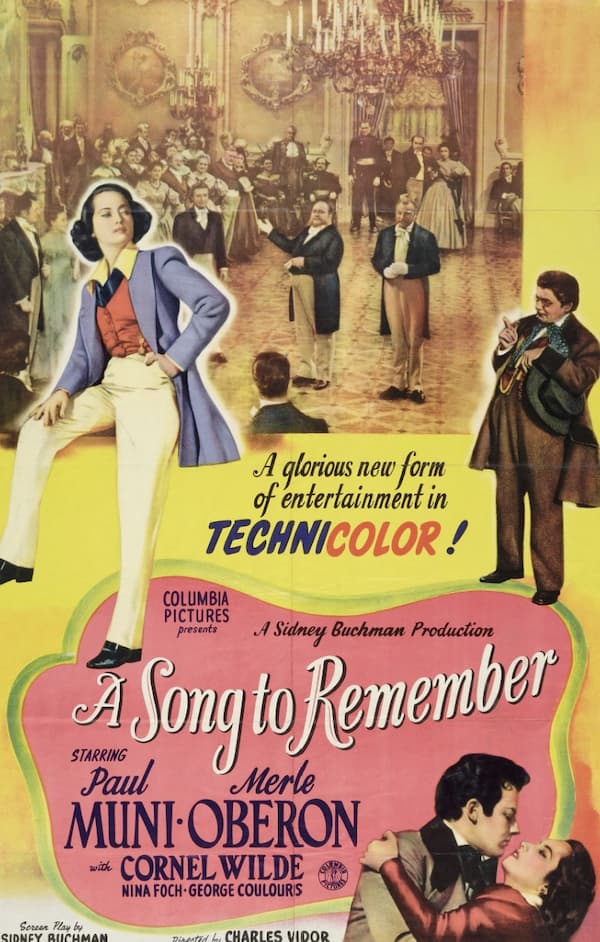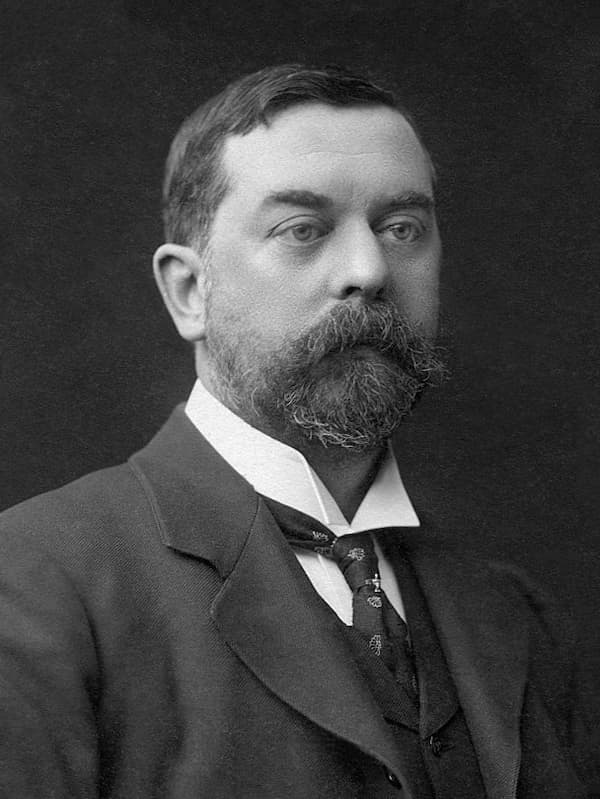From his earliest years to the concert tours in the year he died, Edvard Grieg performed as a pianist playing his own composition. He was a great pianist but not a virtuoso, and according to a biographer, “his intimate familiarity with the piano allowed him to present his own music in such a way as to leave a deep and lasting impression upon everyone who heard him play.” Grieg simply had the ability to bring out the very best in his own piano pieces.
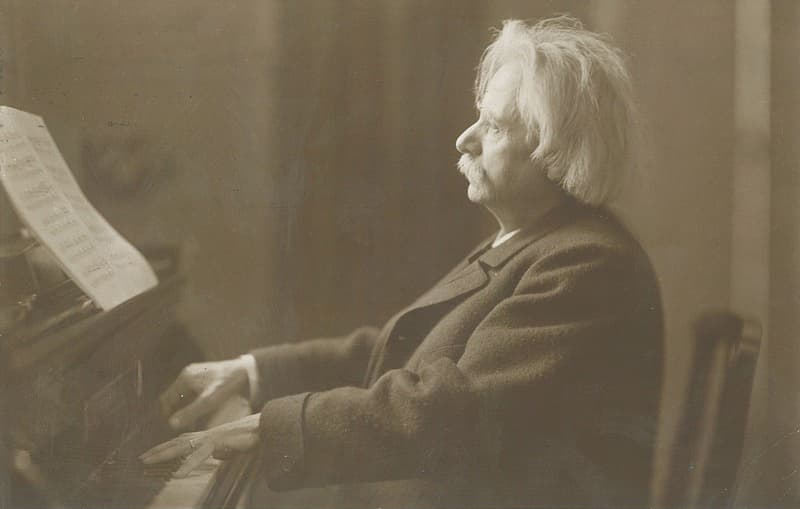
Edvard Grieg with a grand piano, c. 1900
Grieg wrote hundreds of smaller piano compositions, but the collection of 66 Lyric Pieces includes some of his best-known piano music. As Grieg wrote, “The ten volumes of Lyric Pieces form an intimate slice of my life.” Composed between 1867 and 1901, Grieg seemingly wrote a kind of poetic piano diary, and we thought it might be a wonderful project to explore these fantastic piano jewels in a bit more detail.
Edvard Grieg: Lyric Pieces, Book 1, Op. 12 – No. 1. Arietta (Einar Steen-Nøkleberg, piano)
Edvard Grieg: Lyric Pieces, Book 1, Op. 12 – No. 3. Vektersang (Watchman’s Song) (Einar Steen-Nøkleberg, piano)
Even later in life, Grieg, the pianist, was in great popular demand among the general public. In fact, concert managers from around the world eagerly booked him for concert appearances. Critics, on the other hand, were more difficult to please, and a hurt Grieg wrote, “I cannot be blamed if my music is played in third-rate hotels and by school girls. I could not have created my music any other way, even though I did not have my audience in mind at the time. I guess this popularity is all right, but it is dearly bought. My reputation as a composer is suffering because of it.”
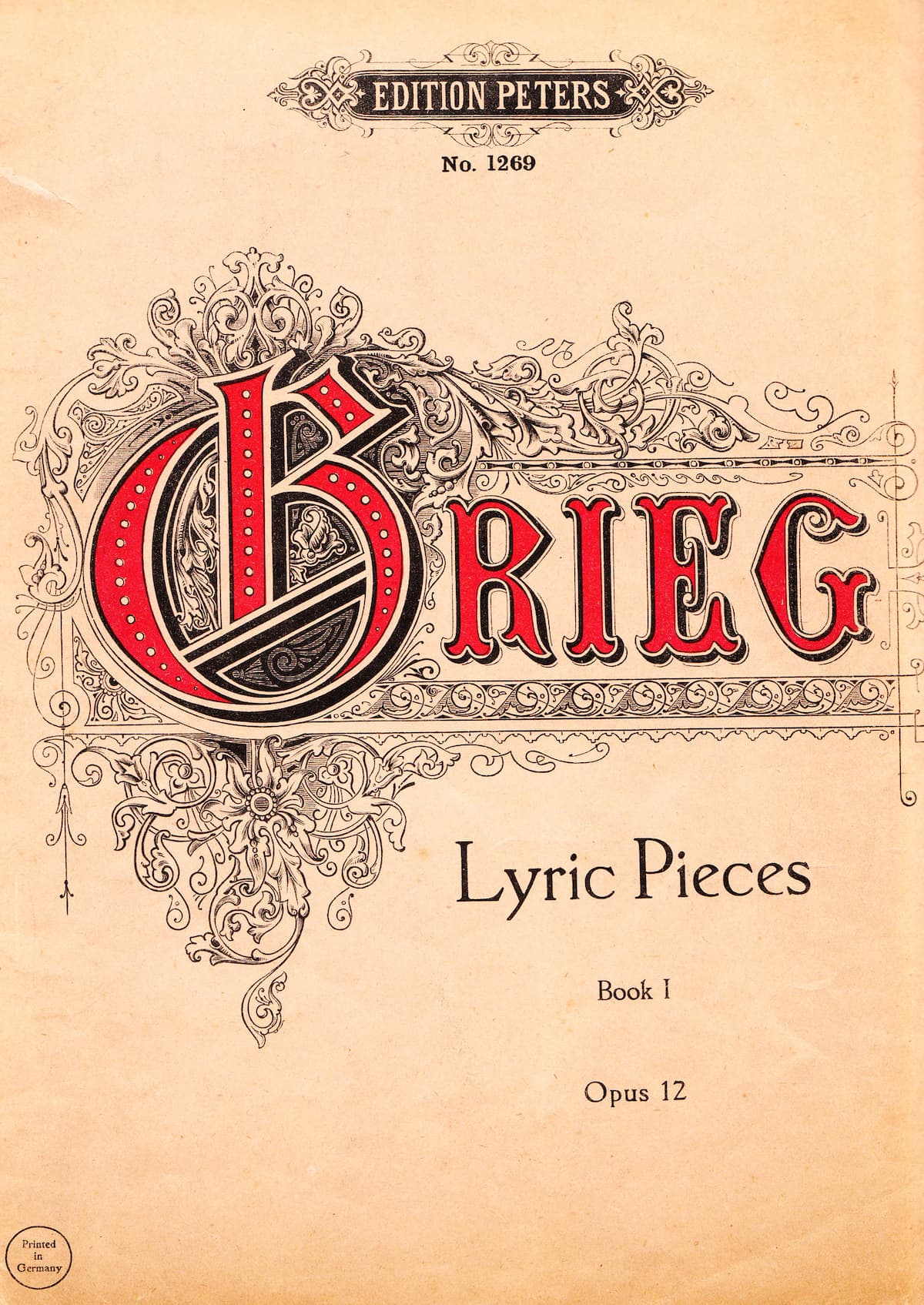
Edvard Grieg’s Lyric Pieces, Op. 12 Book 1
Grieg published his first album in 1867 in Copenhagen, and it contained eight short pieces that were relatively simple to play. Each one, however, has characteristic freshness and charm that made them highly popular. The opening “Arietta” of the first volume of Lyric Pieces is quoted in the final piece of the tenth volume in 1901, thus closing the circle. A delightful “Waltz” is followed by a more solemn “Watchman’s Song,” inspired by a performance of Shakespeare’s Macbeth, with a delicate “Elves’ Dance” offering some delightful contrast. “Album-Leaf” had already been printed in a music periodical, and the concluding “National Anthem” inspired Bjornstjerne Bjornson to write words for it.
Edvard Grieg: Lyric Pieces, Book 1, Op. 12 – No. 7. Albumblad (Marián Lapšanský, piano)
Edvard Grieg: Lyric Pieces, Book 1, Op. 12 – No. 8. Faedrelandssang (Marián Lapšanský, piano)
Grieg was a master of the piano miniature, and many seemed modelled on the pieces Schumann had woven into his piano cycles. However, they are basically simple pieces and beautifully fashioned, and they certainly don’t sound Schumann’s feverish intensity or obsessive moods. Grieg, of course, took influences from his native Norwegian folk music and other composers.
It took Grieg almost sixteen years before he issued his next collection of Lyric Pieces. These little gems had been written and collected over a long period of time “as though he was not quite willing to claim these little pieces as his own.” The second collection of Lyric Pieces opens with a delightful “Cradle Song,” and besides an earlier “Waltz” and “Canon”, includes three pieces directly inspired by Norwegian folk music, the “Folk Melody” and the folk dances “Halling” and “Spring Dance.” Grieg also adds “Melody” and “Elegy” to provide a subtle emotional contrast.
Edvard Grieg: Lyric Pieces, Book 2, Op.38 – No. 1. Berceuse (Cradle Song) (Einar Steen-Nøkleberg, piano)
Edvard Grieg: Lyric Pieces, Book 2, Op.38 – No. 2. Folkevise (Folk Song) (Einar Steen-Nøkleberg, piano)
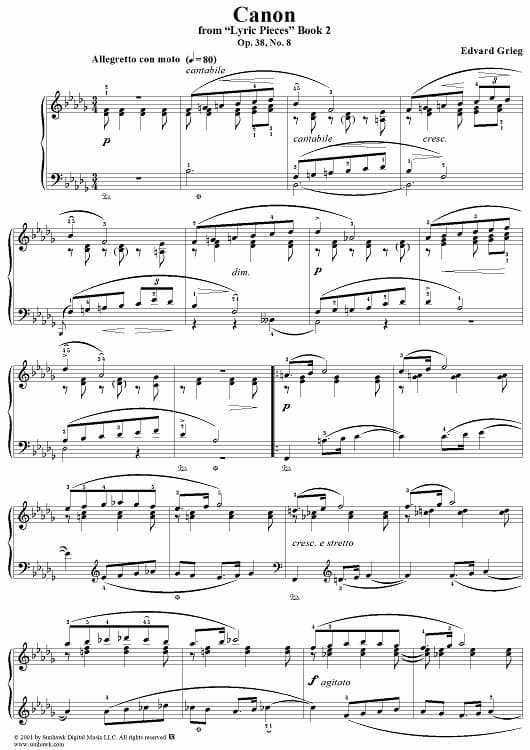
Edvard Grieg’s Lyric Pieces, Op. 38 “Canon”
The expression “Lyric Pieces” is actually Grieg’s own invention. Character pieces for the piano, with or without descriptive titles, have a long tradition and Grieg is adding his contribution. Each of his lyric pieces expresses only one mood or one feeling. They certainly do not call for the extremes of virtuosity. “Yet in shaping melodies, providing harmonic support which subtly adjusts to the melodic line and to changing harmonies, in creating moods and characterization, they call for a great deal of skill and subtlety in the pianist.”
In 1877, Grieg issued his third album of Lyric Pieces as his Opus 43. In this collection, Grieg “created piano pieces of an unusually high and consistent quality, as well as a unity of content which one does not find in the previous volumes.” Grieg completed the set in June and July, describing them in a letter to his publisher as spring songs.
Edvard Grieg: Lyric Pieces, Book 2, Op.38 – No. 5. Springdans (Einar Steen-Nøkleberg, piano)
Edvard Grieg: Lyric Pieces, Book 2, Op. 38 – No. 8. Kanon (Canon) (Einar Steen-Nøkleberg, piano)
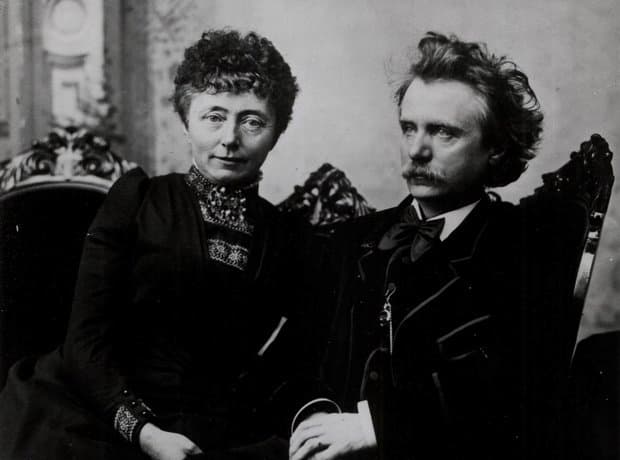
Edvard and Nina Grieg
Grieg writes, “Spring is spring, chirping birds are chirping birds, and one finds them both in abundance here, but they do not move me. Nobody here understands what draws me to our Norwegian nature as you do…The other day, my longing was so deep that I ended in Hymn of Thankful Praise to our rugged and wildly beautiful Norwegian Nature. There is nothing new in it, but it is profoundly sincere.”
You can probably tell that Grieg was a restless person, always longing for another place. When he acquired his first residence, Troldhaugen, in Bergen, he would stay there for a while, but then he missed the pulsating artistic life in Europe. Yet every spring, he would return to Troldhaugen, rush into the house and sit down at the piano. That restless, melancholy, and reflective character is beautifully portrayed in “Solitary Wanderer” and “In my Native Land,” surrounded by “Butterflies” and “Little Bird.”
Edvard Grieg: Lyric Pieces, Book 3, Op. 43 (Isabel Mourao, piano)
Grieg never attempted to hide the fact that his Lyric Pieces gradually became very good business. Not only for Grieg, but also for his publishers. In fact, they sold like hotcakes, and everybody was delighted when Grieg delivered a manuscript of new piano pieces. Grieg did feel some pressure in getting additional volumes to the public, as he wrote to a friend, “I honestly haven’t done anything, other than the so called “Lyric Pieces,” which are surrounding me like lice and fleas in the country.”
The fourth set of Lyric Pieces was published in 1888, in the same year Grieg made his appearance in London as a soloist in his Piano Concerto. Although the miniatures in this set are not as well known, it seems that Grieg had fully assimilated the national folk idioms. In fact, his harmonic language had become much more individual.
Edvard Grieg: Lyric Pieces, Book 4, Op. 47 – No. 1. Valse-Impromptu (Marián Lapšanský, piano)
Edvard Grieg: Lyric Pieces, Book 4, Op. 47 – No. 2. Albumblatt (Album-leaf) (Marián Lapšanský, piano)
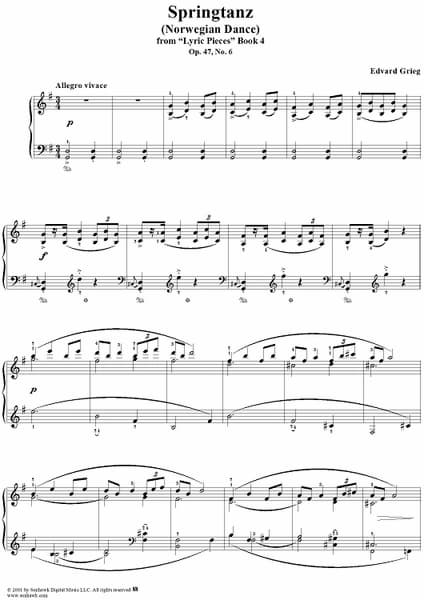
Edvard Grieg’s Lyric Pieces, Op. 47 “Norwegian Dance”
As Grieg told a friend, “the realm of harmony, has always been my dream world, and my relationship to this harmonious way of feeling and the Norwegian folk songs has been a mystery even for me. I have understood that the secret depth one finds in our folk songs is basically owing to the richness of their untold harmonic possibilities. I have always attempted to express my interpretation of these hidden harmonies.”
The first piece of the set, “Valse-impromptu” tips its hat to Chopin with the characteristic fifths in the left hand, while “Melody” has a slightly modal character with the left hand creating a constant ostinato rhythm. Another “Elegy” and “Lyric Piece” are cast in the minor key, sounding rather melancholic. From the first four volumes, it is easy to see why the Lyric Pieces are often considered Grieg’s most characteristic work. But what I like probably best of all is the fact that these tiny piano gems are accessible to the vast majority of amateur pianists. Just about every pianist can get a sense of Grieg’s musical personality and his deep love for his native Norway.
For more of the best in classical music, sign up for our E-Newsletter
Edvard Grieg: Lyric Pieces, Book 4, Op. 47 – No. 5. Melancholie (Melancholy) (Marián Lapšanský, piano)
Edvard Grieg: Lyric Pieces, Book 4, Op. 47 – No. 7. Élégie (Elegy) (Marián Lapšanský, piano)

